- Home
- Edgar Allan Poe
The Science Fiction of Edgar Allan Poe (Penguin Classics) Page 32
The Science Fiction of Edgar Allan Poe (Penguin Classics) Read online
Page 32
A most unfounded opinion has been latterly current in gossiping and even in scientific circles – the opinion that the so-called Nebular Cosmogony has been overthrown. This fancy has arisen from the report of late observations made, among what hitherto have been termed the ‘nebulaæ’, through the large telescope of Cincinnati, and the world-renowned instrument of Lord Rosse. Certain spots in the firmament which presented, even to the most powerful of the old telescopes, the appearance of nebulosity, or haze, had been regarded for a long time as confirming the theory of Laplace. They were looked upon as stars in that very process of condensation which I have been attempting to describe. Thus it was supposed that we ‘had ocular evidence’ – an evidence, by the way, which has always been found very questionable – of the truth of the hypothesis; and, although certain telescopic improvements, every now and then, enabled us to perceive that a spot, here and there, which we had been classing among the nebulæ, was, in fact, but a cluster of stars deriving its nebular character only from its immensity of distance – still it was thought that no doubt could exist as to the actual nebulosity of numerous other masses, the strong-holds of the nebulists, bidding defiance to every effort at segregation. Of these latter the most interesting was the great ‘nebula’ in the constellation Orion: – but this, with innumerable other miscalled ‘nebulæ’, when viewed through the magnificent modern telescopes, has become resolved into a simple collection of stars.36 Now this fact has been very generally understood as conclusive against the Nebular Hypothesis of Laplace; and, on announcement of the discoveries in question, the most enthusiastic defender and most eloquent popularizer of the theory, Dr Nichol, went so far as to ‘admit the necessity of abandoning’ an idea which had formed the material of his most praiseworthy book.*
Many of my readers will no doubt be inclined to say that the result of these new investigations has at least a strong tendency to overthrow the hypothesis; while some of them, more thoughtful, will suggest that, although the theory is by no means disproved through the segregation of the particular ‘nebulæ’ alluded to, still a failure to segregate them, with such telescopes, might well have been understood as a triumphant corroboration of the theory: – and this latter class will be surprised, perhaps, to hear me say that even with them I disagree. If the propositions of this Discourse have been comprehended, it will be seen that, in my view, a failure to segregate the ‘nebulæ’ would have tended to the refutation, rather than to the confirmation, of the Nebular Hypothesis.
Let me explain: – The Newtonian Law of Gravity we may, of course, assume as demonstrated. This law, it will be remem bered, I have referred to the rëaction of the first Divine Act – to the rëaction of an exercise of the Divine Volition temporarily overcoming a difficulty. This difficulty is that of forcing the normal into the abnormal – of impelling that whose originality, and therefore whose rightful condition, was One, to take upon itself the wrongful condition of Many. It is only by conceiving this difficulty as temporarily overcome, that we can comprehend a reaction. There could have been no rëaction had the act been infinitely continued. So long as the act lasted, no rëaction, of course, could commence; in other words, no gravitation could take place – for we have considered the one as but the manifestation of the other. But gravitation has taken place; therefore the act of Creation has ceased: and gravitation has long ago taken place; therefore the act of Creation has long ago ceased. We can no more expect, then, to observe the primary processes of Creation; and to these primary processes the condition of nebulosity has already been explained to belong.
Through what we know of the propagation of light, we have direct proof that the more remote of the stars have existed, under the forms in which we now see them, for an inconceivable number of years. So far back at least, then, as the period when these stars underwent condensation, must have been the epoch at which the mass-constitutive processes began. That we may conceive these processes, then, as still going on in the case of certain ‘nebulæ’, while in all other cases we find them thoroughly at an end, we are forced into assumptions for which we have really no basis whatever – we have to thrust in, again, upon the revolting Reason, the blasphemous idea of special interposition – we have to suppose that, in the particular instances of these ‘nebulæe’, an unerring God found it necessary to introduce certain supplementary regulations – certain improvements of the general law – certain retouchings and emendations, in a word, which had the effect of deferring the completion of these individual stars for centuries of centuries beyond the æra during which all the other stellar bodies had time, not only to be fully constituted, but to grow hoary with an unspeakable old age.
Of course, it will be immediately objected that since the light by which we recognize the nebulæ now, must be merely that which left their surfaces a vast number of years ago, the processes at present observed, or supposed to be observed, are, in fact, not processes now actually going on, but the phantoms of processes completed long in the Past – just as I maintain all these mass-constitutive processes must have been.
To this I reply that neither is the now-observed condition of the condensed stars their actual condition, but a condition completed long in the Past; so that my argument drawn from the relative condition of the stars and the ‘nebulaæ’, is in no manner disturbed. Moreover, those who maintain the existence of nebulæ, do not refer the nebulosity to extreme distance; they declare it a real and not merely a perspective nebulosity. That we may conceive, indeed, a nebular mass as visible at all, we must conceive it as very near us in comparison with the condensed stars brought into view by the modern telescopes. In maintaining the appearances in question, then, to be really nebulous, we maintain their comparative vicinity to our point of view. Thus, their condition, as we see them now, must be referred to an epoch far less remote than that to which we may refer the now-observed condition of at least the majority of the stars. – In a word, should Astronomy ever demonstrate a ‘nebula’, in the sense at present intended, I should consider the Nebular Cosmogony – not, indeed, as corroborated by the demonstration – but as thereby irretrievably overthrown.
By way, however, of rendering unto Cæsar no more than the things that are Cæsar’s, let me here remark that the assumption of the hypothesis which led him to so glorious a result, seems to have been suggested to Laplace in great measure by a misconception – by the very misconception of which we have just been speaking – by the generally prevalent misunderstanding of the character of the nebulæ, so mis-named. These he supposed to be, in reality, what their designation implies. The fact is, this great man had, very properly, an inferior faith in his own merely perceptive powers. In respect, therefore, to the actual existence of nebulæ – an existence so confidently maintained by his telescopic contemporaries – he depended less upon what he saw than upon what he heard.
It will be seen that the only valid objections to his theory, are those made to its hypothesis as such – to what suggested it – not to what it suggests; to its propositions rather than to its results. His most unwarranted assumption was that of giving the atoms a movement towards a centre, in the very face of his evident understanding that these atoms, in unlimited succession, extended throughout the Universal space. I have already shown that, under such circumstances, there could have occurred no movement at all; and Laplace, consequently, assumed one on no more philosophical ground than that something of the kind was necessary for the establishment of what he intended to establish.
His original idea seems to have been a compound of the true Epicurean atoms with the false nebulæ of his contemporaries; and thus his theory presents us with the singular anomaly of absolute truth deduced, as a mathematical result, from a hybrid datum of ancient imagination intertangled with modern inacumen. Laplace’s real strength lay, in fact, in an almost miraculous mathematical instinct: – on this he relied; and in no instance did it fail or deceive him: – in the case of the Nebular Cosmogony, it led him, blindfolded, through a labyrinth of Error, into one of the most
luminous and stupendous temples of Truth.
Let us now fancy – merely fancy – for the moment, that the ring first thrown off by the Sun – that is to say, the ring whose breaking-up constituted Neptune – did not, in fact, break up until the throwing-off of the ring out of which Uranus arose; that this latter ring, again, remained perfect until the discharge of that out of which sprang Saturn; that this later, again, remained entire until the discharge of that from which originated Jupiter – and so on. Let us imagine, in a word, that no dissolution occurred among the rings until the final rejection of that which gave birth to Mercury. We thus paint to the eye of the mind a series of cöexistent concentric circles; and looking as well at them as at the processes by which, according to Laplace’s hypothesis, they were constructed, we perceive at once a very singular analogy with the atomic strata and the process of the original radiation as I have described it. Is it impossible that, on measuring the forces, respectively, by which each successive planetary circle was thrown off – that is to say, on measuring the successive excesses of rotation over gravitation which occasioned the successive discharges – we should find the analogy in question more decidedly confirmed? Is it improbable that we shall discover these forces to have varied – as in the original radiation – proportionally with the squares of the distances?
Our solar system, consisting, in chief, of one sun, with seventeen planets certainly, and possibly a few more, revolving about it at various distances, and attended by seventeen moons assuredly, but very probably by several others – is now to be considered as an example of the innumerable agglomerations which proceeded to take place throughout the Universal Sphere of atoms on withdrawal of the Divine Volition. I mean to say that our solar system is to be understood as affording a generic instance of these agglomerations, or, more correctly, of the ulterior conditions at which they arrived. If we keep our attention fixed on the idea of the utmost possible Relation as the Omnipotent design, and on the precautions taken to accomplish it through difference of form, among the original atoms, and particular inequidistance, we shall find it impossible to suppose for a moment that even any two of the incipient agglomerations reached precisely the same result in the end. We shall rather be inclined to think that no two stellar bodies in the Universe – whether suns, planets or moons – are particularly, while all are generally, similar. Still less, then, can we imagine any two assemblages of such bodies – any two ‘systems’ – as having more than a general resemblance.* Our telescopes, at this point, thoroughly confirm our deductions. Taking our own solar system, then, as merely a loose or general type of all, we have so far proceeded in our subject as to survey the Universe of Stars under the aspect of a spherical space, throughout which, dispersed with merely general equability, exist a number of but generally similar systems.
Let us now, expanding our conceptions, look upon each of these systems as in itself an atom; which in fact it is, when we consider it as but one of the countless myriads of systems which constitute the Universe. Regarding all, then, as but colossal atoms, each with the same ineradicable tendency to Unity which characterizes the actual atoms of which it consists – we enter at once on a new order of aggregations. The smaller systems, in the vicinity of a larger one, would, inevitably, be drawn into still closer vicinity. A thousand would assemble here; a million there – perhaps here, again, even a billion – leaving, thus, immeasurable vacancies in space. And if, now, it be demanded why, in the case of these systems – of these merely Titanic atoms – I speak, simply, of an ‘assemblage’, and not, as in the case of the actual atoms, of a more or less consolidated agglomeration: – if it be asked, for instance, why I do not carry what I suggest to its legitimate conclusion, and describe, at once, these assemblages of system-atoms as rushing to consolidation in spheres – as each becoming condensed into one magnificent sun – my reply is that 37 – I am but pausing, for a moment, on the awful threshold of the Future. For the present, calling these assemblages ‘clusters’, we see them in the incipient stages of their consolidation. Their absolute consolidation is to come.
We have now reached a point from which we behold the Universe of Stars as a spherical space, interspersed, unequably, with clusters. It will be noticed that I here prefer the adverb ‘unequably’ to the phrase ‘with a merely general equability’, employed before. It is evident, in fact, that the equability of distribution will diminish in the ratio of the agglomerative processes – that is to say, as the things distributed diminish in number. Thus the increase of inequability – an increase which must continue until, sooner or later, an epoch will arrive at which the largest agglomeration will absorb all the others – should be viewed as, simply, a corroborative indication of the tendency to One.
And here, at length, it seems proper to inquire whether the ascertained facts of Astronomy confirm the general arrangement which I have thus, deductively, assigned to the Heavens. Thoroughly, they do. Telescopic observation, guided by the laws of perspective, enables us to understand that the perceptible Universe exists as a roughly spherical cluster of clusters, irregularly disposed.
The ‘clusters’ of which this Universal ‘cluster of clusters’ consists, are merely what we have been in the practice of designating ‘nebulæ’ and, of these ‘nebulæ’, one is of paramount interest to mankind. I allude to the Galaxy, or Milky Way. This interests us, first and most obviously, on account of its great superiority in apparent size, not only to any one other cluster in the firmament, but to all the other clusters taken together. The largest of these latter occupies a mere point, comparatively, and is distinctly seen only with the aid of a telescope. The Galaxy sweeps throughout the Heaven and is brilliantly visible to the naked eye. But it interests man chiefly, although less immediately, on account of its being his home; the home of the Earth on which he exists; the home of the Sun about which this Earth revolves; the home of that ‘system’ of orbs of which the Sun is the centre and primary – the Earth one of seventeen secondaries, or planets – the Moon one of seventeen tertiaries, or satellites. The Galaxy, let me repeat, is but one of the clusters which I have been describing – but one of the mis-called ‘nebulæ’ revealed to us – by the telescope alone, sometimes – as faint hazy spots in various quarters of the sky. We have no reason to suppose the Milky Way really more extensive than the least of these ‘nebulæ’. Its vast superiority in size is but an apparent superiority arising from our position in regard to it – that is to say, from our position in its midst. However strange the assertion may at first appear to those unversed in Astronomy, still the astronomer himself has no hesitation in asserting that we are in the midst of that inconceivable host of stars – of suns – of systems – which constitute the Galaxy. Moreover, not only have we – not only has our Sun a right to claim the Galaxy as its own especial cluster, but, with slight reservation, it may be said that all the distinctly visible stars of the firmament – all the stars visible to the naked eye – have equally a right to claim it as their own.
There has been a great deal of misconception in respect to the shape of the Galaxy; which, in nearly all our astronomical treatises, is said to resemble that of a capital Y. The cluster in question has, in reality, a certain general – very general resembance to the planet Saturn, with its encompassing triple ring. Instead of the solid orb of that planet, however, we must picture to ourselves a lenticular star-island, or collection of stars; our Sun lying excentrically – near the shore of the island – on that side of it which is nearest the constellation of the Cross and farthest from that of Cassiopeia. The surrounding ring, where it approaches our position, has in it a longitudinal gash, which does, in fact, cause the ring, in our vicinity, to assume, loosely, the appearance of a capital Y.
We must not fall into the error, however, of conceiving the somewhat indefinite girdle as at all remote, comparatively speaking, from the also indefinite lenticular cluster which it surrounds; and thus, for mere purpose of explanation, we may speak of our Sun as actually situated at that point of the Y where its
three component lines unite; and, conceiving this letter to be of a certain solidity – of a certain thickness, very trivial in comparison with its length – we may even speak of our position as in the middle of this thickness. Fancying ourselves thus placed, we shall no longer find difficulty in accounting for the phænomena presented – which are perspective altogether. When we look upward or downward – that is to say, when we cast our eyes in the direction of the letter’s thickness – we look through fewer stars than when we cast them in the direction of its length, or along either of the three component lines. Of course, in the former case, the stars appear scattered – in the latter, crowded. – To reverse this explanation: – An inhabitant of the Earth, when looking, as we commonly express ourselves, at the Galaxy, is then beholding it in some of the directions of its length – is looking along the lines of the Y – but when, looking out into the general Heaven, he turns his eyes from the Galaxy, he is then surveying it in the direction of the letter’s thickness; and on this account the stars seem to him scattered; while, in fact, they are as close together, on an average, as in the mass of the cluster. No consideration could be better adapted to convey an idea of this cluster’s stupendous extent.

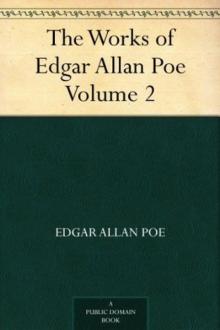 The Works of Edgar Allan Poe — Volume 2
The Works of Edgar Allan Poe — Volume 2 The Works of Edgar Allan Poe — Volume 1
The Works of Edgar Allan Poe — Volume 1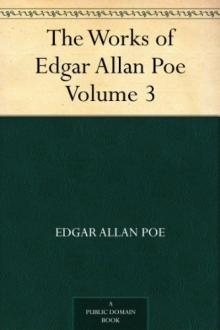 The Works of Edgar Allan Poe — Volume 3
The Works of Edgar Allan Poe — Volume 3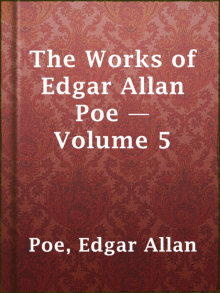 The Works of Edgar Allan Poe — Volume 5
The Works of Edgar Allan Poe — Volume 5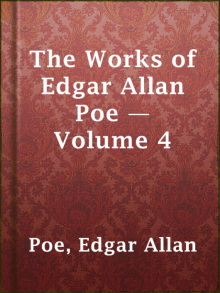 The Works of Edgar Allan Poe — Volume 4
The Works of Edgar Allan Poe — Volume 4 The Tell-Tale Heart
The Tell-Tale Heart The Raven (Penguin)
The Raven (Penguin) The Paris Mysteries
The Paris Mysteries Tales of Terror from Edgar Allan Poe
Tales of Terror from Edgar Allan Poe The Fall of the House of Usher
The Fall of the House of Usher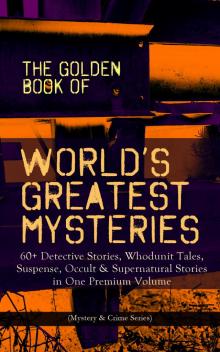 The Golden Book of World's Greatest Mysteries
The Golden Book of World's Greatest Mysteries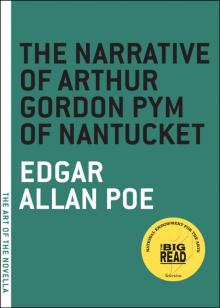 The Narrative of Arthur Gordon Pym of Nantucket
The Narrative of Arthur Gordon Pym of Nantucket Ligeia
Ligeia The Landscape Garden
The Landscape Garden Complete Tales & Poems
Complete Tales & Poems Great Tales and Poems of Edgar Allan Poe
Great Tales and Poems of Edgar Allan Poe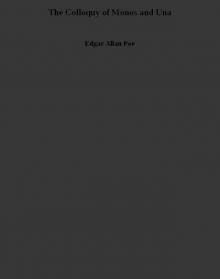 The Colloquy of Monos and Una
The Colloquy of Monos and Una The Oblong Box
The Oblong Box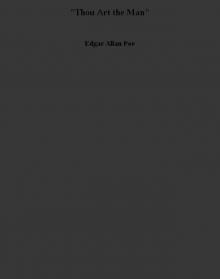 Thou Art the Man
Thou Art the Man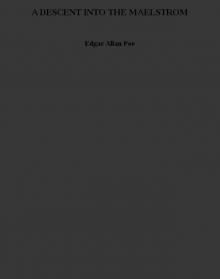 A DESCENT INTO THE MAELSTROM
A DESCENT INTO THE MAELSTROM THE MURDERS IN THE RUE MORGUE
THE MURDERS IN THE RUE MORGUE The Business Man
The Business Man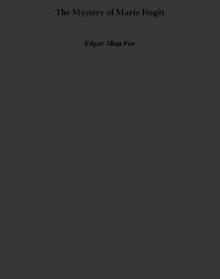 The Mystery of Marie Rogêt
The Mystery of Marie Rogêt Metzengerstein
Metzengerstein The Man That Was Used Up
The Man That Was Used Up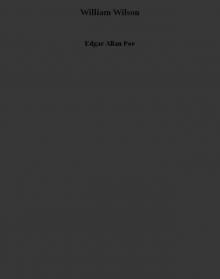 William Wilson
William Wilson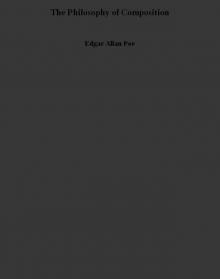 The Philosophy of Composition
The Philosophy of Composition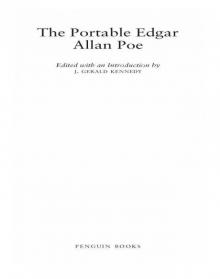 The Portable Edgar Allan Poe
The Portable Edgar Allan Poe Bon-Bon
Bon-Bon A Predicament
A Predicament The Premature Burial
The Premature Burial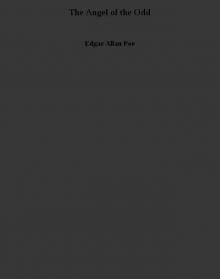 The Angel of the Odd
The Angel of the Odd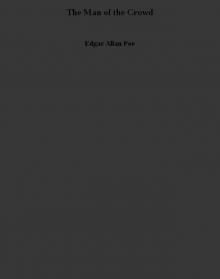 The Man of the Crowd
The Man of the Crowd Never Bet the Devil Your Head
Never Bet the Devil Your Head The Tell-Tale Heart and Other Writings
The Tell-Tale Heart and Other Writings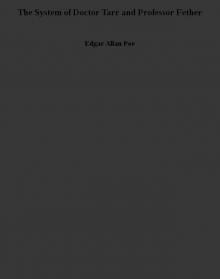 The System of Doctor Tarr and Professor Fether
The System of Doctor Tarr and Professor Fether Selected Tales (Oxford World's Classics)
Selected Tales (Oxford World's Classics) Essential Tales and Poems of Edgar Allan Poe (Barnes & Noble Classics Series)
Essential Tales and Poems of Edgar Allan Poe (Barnes & Noble Classics Series) MS. Found in a Bottle
MS. Found in a Bottle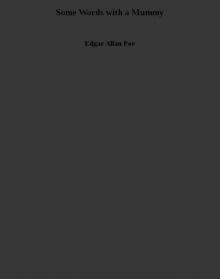 Some Words with a Mummy
Some Words with a Mummy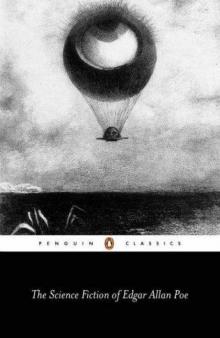 The Science Fiction of Edgar Allan Poe (Penguin Classics)
The Science Fiction of Edgar Allan Poe (Penguin Classics) King Pest
King Pest CRITICISM
CRITICISM How to Write a Blackwood Article
How to Write a Blackwood Article Mystification
Mystification Diddling Considered as One of the Exact Sciences
Diddling Considered as One of the Exact Sciences Steampunk Poe
Steampunk Poe The Literary Life of Thingum Bob, Esq.
The Literary Life of Thingum Bob, Esq. Classic Crime Collection
Classic Crime Collection Complete Stories and Poems of Edgar Allen Poe
Complete Stories and Poems of Edgar Allen Poe Berenice
Berenice The Black Cat
The Black Cat The Slender Poe Anthology
The Slender Poe Anthology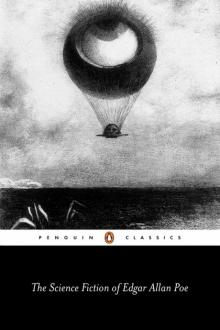 The Science Fiction of Edgar Allan Poe
The Science Fiction of Edgar Allan Poe The Assignation
The Assignation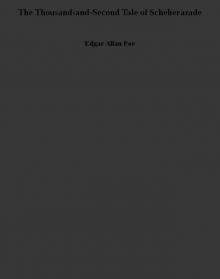 The Thousand-and-Second Tale of Scheherazade
The Thousand-and-Second Tale of Scheherazade The Raven and Other Short Stories
The Raven and Other Short Stories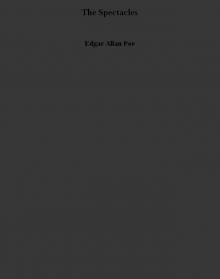 The Spectacles
The Spectacles Hop-Frog
Hop-Frog The Purloined Letter
The Purloined Letter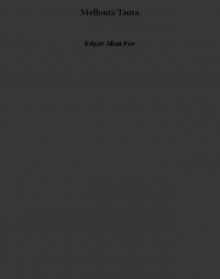 Mellonta Tauta
Mellonta Tauta The Balloon-Hoax
The Balloon-Hoax Landor's Cottage
Landor's Cottage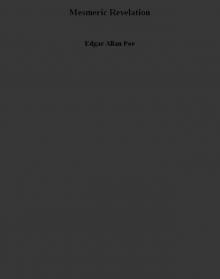 Mesmeric Revelation
Mesmeric Revelation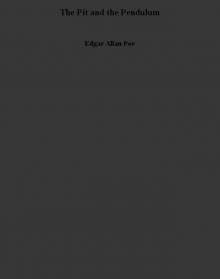 The Pit and the Pendulum
The Pit and the Pendulum